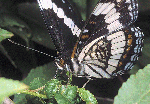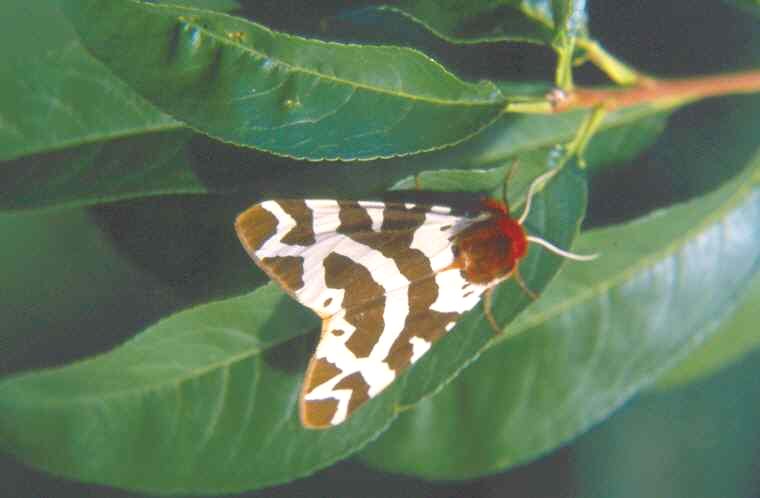
Utah Lepidopterists' Society
Founded 6 Nov 1976

|
|
Utah Lepidopterists' Society Founded 6 Nov 1976 |
|
| History | Mission | Meetings | Bulletin | Checklists | Links | Community | Field Trips | Habitat | Members | Kids | Contact Us |
Volume 10 - No. 1, September 2002
|
On 22 August 2002, Utah became the first state in the United
States to prove having 100 or more butterfly plus skipper species within
all of its (29) counties! For quite a few decades, I have been deeply
engaged in gaining all aspects of knowledge I could, concerning the
butterflies of Utah specifically and bfs of the western US generally.
Basic data in this bf research consists of establishing Core Records (the
SR, ER, LR, HE, LE, dLFs, etc) for all bf species, which naturally
includes compiling detailed distribution data at state and county levels.
Since I strongly believe that skippers are not butterflies, total
species-number comparisons with totals compiled by those whose compilation
systems include skippers as butterflies are not meaningful, or even
possible. While there are five Utah counties with 100 or more proven bf
species (and with only 17 specific records, there would be five more
counties), I didn’t even think to attempt obtaining 100 or more
butterfly species for all of Utah’s twenty-nine counties. Then, on 10 Aug 2002, I received a letter from Ray E. Stanford, MD
[official coordinator for bf & sk distribution for the
Lepidopterists’ Society in certain Intermountain western states and a
co-author for bf & sk distribution for the Northern Prairie Wildlife
Research Center (NPWRC)], informing me that within their combined
compilation system, there were only four Utah counties [Rich (Ri), Weber
(We), Morgan (Mo), & Carbon (Cb)] for which they did not already have
at least one hundred species! That was an amazing surprise to me,
considering that I do not use skippers in my totals. Dr Stanford stated
that only 14 specific records (Ri 3, We 2, Mo 7, & Cb 2) would be
needed by him to put Utah over the top as being the very first state
having proved 100 or more species for all of its counties. He also
suggested that UT skipper records would be a good source of data to fill
the gap and included a "hitlist" of skipper species needed in
each of the four counties. I immediately, and wholeheartedly, signed on to
his program and made it a Special Project for our Utah Lepidopterists’
Society, informing some of our members, but especially the skipper people
we have. I informed RES that I truly believed the Utah Lepids’ Soc could
accomplish our now combined goal within two months (2 ULS meetings plus 2
days). Phase one would be to gather in past skipper records, and Phase two
would be to go collect new skipper records. When it quickly became obvious
that a skipper solution would not even come close to accomplishing our
major objective, we opened up Phase three, which was a butterfly-oriented
solution. Early on in this special project, I knew I could use my own past
butterfly collection records to put Rich, Weber, and Carbon Cos over the
top, if needed. I later supplied RES (and thru him, the NPWRC) Euc.
hyantis, Pol. faunus, & Cha. palla records for Ri UT; Euc. hyantis, Ple. acmon, & Cha.
gorgone records for We UT; and Nym. californica & Spe.
leto for Cb UT. But putting Morgan Co over the top, requiring
at least seven specific records, was quite another matter. [Morgan Co,
incidentally, is a first-class nemesis for Dr Stanford because of a
serious personal injury he sustained there previously.] Using my own
personal collection records, I knew we could go over the top, or come very
close. Then Stanford informed me that he already had H. Avery Freeman (HAF)
Jun 1944 Croydon Station, Devils Slide, Mo UT records for Bas.
archippus, Cha. gorgone, Bol. selene, & Cer. pegala included
in his 93 total, which previously I hadn’t known about. Therefore, my
needed seven records couldn’t include any of those four. By special request, RES
sent me a list of specific bf species we needed for Morgan Co.
Fortunately, I already had record data for six of the seven bf species on
his "hitlist", ranging from 20 Jun 74 thru 29 May 93. Since I
was still short one record, I dug even deeper into my butterfly record
files. RES was later supplied with Mo UT county records for Par.
phoebus, Euc. hyantis, Apo. mormo, Ade. bredowi, Van. virginiensis, Pol.
faunus, & Bol. kriemhild. [It was the 9 Jul 88 Ade.
bredowi record that put us over the top! It was found last because RES
had not included it in his Mo UT needed "hitlist".] All 15
butterfly records which put Utah as the "First State" were
personal, CFG-established records, except the Cha. gorgone 17 Apr
49 We UT record which was uncovered during a much earlier Weber State
Collection inventory. Distribution records of
the presently proven 159 species of Utah butterflies range from the first
known or extant record for a Utah bf, Apo. palmeri DEP 7 Jun 1870 v
St George 8/27 Virgin R Vy, Wa UT thru the last State Record to be added
to the Utah list, Sat. liparops CFG 19 Jul 2000 Gr UT. Dr Edward
Palmer of the Smithsonian collected 23 additional bf species in Washington
(Wa), Iron (Ir), & Beaver (Be) counties thru May, Jun, & Jul of
1877. The second extant bf record for Utah was Cha. acastus HWH
(Henry W. Henshaw) in Provo Cn, Ut UT in 1872 or 1874. Utah’s original
big three bf stalwarts are G. Wesley Browning, born Salt Lake City
(1868-1951 = 83); John Wms Sugden, born Doncaster, Yorkshire ENG
(1867-1935 = 68); and Thomas U. Spalding, born Woodbridge, Suffolk
ENG (1866-1929 = 62). The "big three’s" first extant records
are: Polygonia
zephyrus GWB
17 Sep 1893 City
Creek Cn ----- Ws Wstch Mts,
SL UT Polygonia
satyrus JWS
-- Jul 1894 Salt
Lake City s 13/43 Salt Lake Vy,
SL UT Pieris
beckeri TUS
24 May 1902 v
Stockton
16/51
Ut Hw 36, To UT Ashby D. Boyle, born
Ogden (1886-1960 = 73) whose first extant collection was Pol. faunus
30 Aug 1925 Brighton 27/87 Big Ctnwd Cn, SL UT, was another main (2nd
group) Utah collector. ADB established 8.5 Utah SRs fr 30 Aug 1925 thru 25
May 1936. [I met ADB, an attorney, at his #61 S. Univ. St, SLC home, as a
nine-yr-old after reading about his discovery of Erebia magdalena
on Bald Mtn in the western Uinta Mts, as published in the May 1936 Ntl
Geographic:672× 1. (The elev published in error, 10,000 ft, is 1900 ft
below "near the summit" as stated.) My first great love of bfs
was and is Bas. weidemeyeri (western admiral). After ADB, and
seeing live black alpines on Bald Mtn, Ere. magdalena became my
next big favorite.] Another main (2nd group) collector was Leman D. Pfouts
of Payson, Ut UT, born near Wilmot, St OH (1879-1967 = 87), who
established the SRs for Van. virginiensis (painted beauty) 16 Jul
1932 Ut UT, and Ple. glandon (boreal blue) 20 Jul 1933 Du UT. (I
believe our primary Utah moth coordinator/compiler, Joel
M. Johnson, was acquainted with LDP while Joel was a younger person.) Other notable (older
time) collectors in Utah are: F. Martin Brown, John A. Comstock, MD,
Willis J. Gertsch, Jeane D. Gunder, Alexander B. Klots, PhD, Philip
Laurent, Theodore L. Mead, Vladimir V. Nabokov, Berthold Neumoegen, Dr
Henry Skinner, MD, Arthur J. Snyder, Prof, Dr John (W) Sugden, MD, and
Vasco M. Tanner. Later, and then more
modern main bf collectors include: Curtis J. Callaghan, Ezra R. Day, John
C. Downey, PhD, J. Bruce Duncan, Wilford J. Hanson, PhD, George F.
Knowlton, PhD, T. Blaine Moore, W. Levi Phillips, J.A. Rowe, & Ray E.
Stanford, MD. Special mention should be made of two current UT collectors:
Kenneth B. Tidwell,
almost singlehandedly, kept Utah on the lepidoptera map for quite a few of
those mid-years, searching out many new UT locations, establishing 8
notable State Records (fr 4 Jun 1960 thru 30 Mar 1971), and a large number
of CRs and other UT bf core records including larval foodplants. When Jack
L. Harry arrived on the Utah scene, there were not too many SRs to
still be uncovered, tho he was the first to discover Min. leda (catclaw
hairstreak) 28 Jul 1988 in Wa UT. In addition to his arctic &
antarctic explorations, and his expertise on hairstreak bfs, Jack is known locally for
the extremely large volume of CRs, other core records, and especially for
the very numerous UT documented larval foodplant (dLF) data he has
established. JLH is a dedicated, doggedly determined lepidoptera
researcher who is capable and willing to go just about anywhere to get the
data he is out to obtain. He is persistent enough to nearly always
succeed. Special mention also must be given here to our two primary Utah
skipper specialists – Stephen
W. Sommerfeld and Todd
L. Stout. (At this time, we are not highlighting our very
knowledgeable ULS moth people since this is not a moth project.) My sincere apology goes
out to any and all persons who should have been listed individually but
were not. A large bulk of my Utah bf Core Records comes from single,
unmentioned individuals who from time to time check with me to see if so
& so is new data I need. When it is – that person and his or her
data becomes a part of my Compilation System. Most of these highly
appreciated people are local UT collectors, but many are not. And, most of
them are members of the ULS, and some are not. There is no question that
the founding of the Utah Lepidopterists’ Society on Sat, 6 Nov 1976
in Rm 319 of the library building at the University of Utah, Salt Lake
City, SL UT, with Emily C. Dial and myself as the original instigators –
has greatly facilitated the establishment and dissemination of lepidoptera
knowledge, oriented primarily, but not exclusively, on Utah. It is to all
of those groups mentioned: the very early, usually well-educated
Easterners, the first UT big three (GWB, JWS, & TUS), the UT 2nd group
such as ADB × DJS & ERD, all of whom I have met and conferred with
(now all having left the scene), the mid-group such as JCD × KBT × etc,
the heavy ULS collectors JLH & still including KBT, the out-of-state
contributors (especially RES), and the continuing lower-volume
contributors – that full credit is given for the slow,
persistent, general accumulation of butterfly State and County Records
that allowed UTAH to become the First of a few rare states which has
proven (or will prove) 100 or more butterflies, plus skippers, for all of
its counties. It is Dr Stanford’s
well-reasoned opinion that very few other states will ever be able to
achieve the status just recently achieved by Utah. In the west, Wyoming
will most likely be the second state to achieve such status, according to
RES, and Nevada could possibly be third, which I doubt. He predicts that
eventually 70 same-species will be found in all 24 WY counties, surpassing
all other western states. (If restricted to butterflies only, I personally
do not believe that WY will surpass UT.) Thanks again to all of
you (especially RES) who have, thru the years, contributed to the success
of this "UTAH First" project. All images of Limenitis weidemeyeri on the ULS Info Bar courtesy Jay Cossey |